by Tom Gaylord, a.k.a. B.B. Pelletier
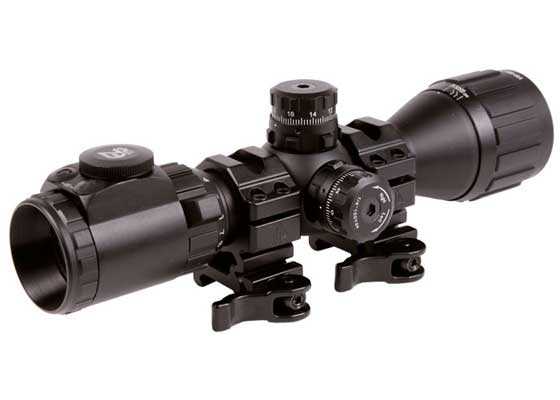
The 3-9x Bug Buster packs a lot of performance into a small package.
Today, we’ll start looking at Leapers’ new 3-9X32 UTG Bug Buster rifle scope. As you know from yesterday’s blog, I’ve mounted this scope on the Evanix Rainstorm 3D Bullpup for testing. I feel the small scope compliments the compact size of the bullpup.
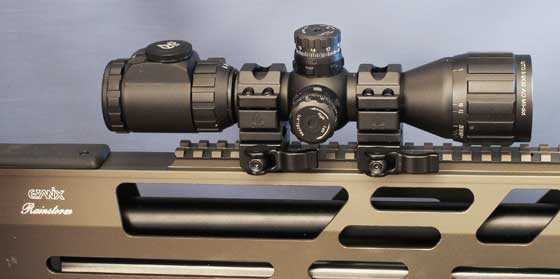
The Bug Buster looks good on the Rainstorm 3D bullpup.
Boy, has Leapers come a long way with the Bug Buster since it first came out! First of all, let’s get the introductions out of the way. Leapers is the manufacturer. UTG, short for Under The Gun, is one of their product lines. Bug Buster is a name that airgunners gave to this scope when it first came out. Because it held (and still holds) the world record for close parallax adjustment, which in practical terms is the same as focusing, the compact scope was touted for shooting insects as soon as it hit the market. Someone coined the name Bug Buster, and Leapers adopted it as their own.
That first Bug Buster was a fixed 4x scope. Today, I’m testing a 3-9x variable. What a difference that makes. Not only can you focus as close as 9 feet, you can also magnify your target 9 times at that distance! If you’re sighted-in, you can pick which part of the bug to eliminate.
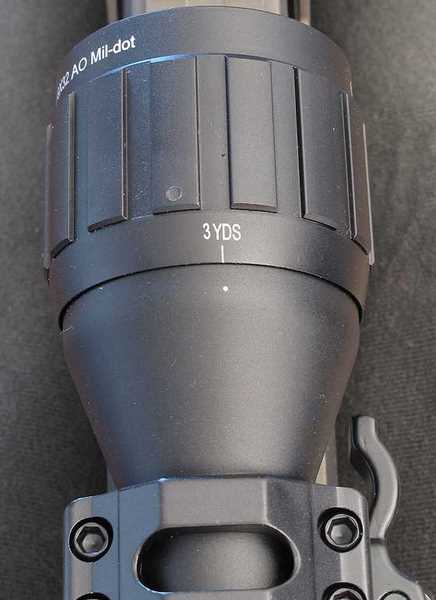
This is something no other scope in the world offers — parallax correction down to 3 yards!
But there’s a whole lot more than just close focusing. This Bug Buster comes with lockable turrets, which are the adjustment knobs for windage and elevation. To lock or unlock them, a ring at the bottom is loosened or tightened. Do it once and it will seem intuitive.
The zero can also be reset; so once the scope is zeroed for a certain range, the scale can be repositioned so it reads zero. This allows you to adjust the scope from this zero and see how far you’ve gone — as long as you don’t go farther than one full rotation of the adjustment knob. It’s very handy for hunters who wish to change their scope zero in the field.
The reticle
The big reason I’m testing this scope is the reticle. Early Bug Busters had one shortcoming — a thick reticle. Precision aiming was difficult , if not impossible, because the crosshairs covered so many inches at 100 yards. That’s what’s changed in the new Bug Buster. The reticle is a mil-dot. The reticle lines are now about medium-sized. They won’t cover too much of your target, and yet you can still find them while hunting in a dark forest that has lots of shadows.
There are dots on the inner lines in both directions. The centers of the dots are one mil apart, which provides a refernce for measuring angles through the scope. And angles can be turned into distances if you know the approximate size of what you’re measuring.
In the Army, we had to learn the approximate size of common battlefield equipment such as tanks and personnel carriers so we could calculate the distance to them with binoculars that had a mil-scale reticle. Hunters need to learn the same sorts of things, but for the animals they’re likely to spot. That information, coupled with the tutorial in the scope’s owner’s manual, will help you calculate distances to your target.
The reticle is illuminated with Leapers’ patented EZ-TAP lighting system. Two buttons atop the scope control the intensity and selection of the colors. Now, I’m colorblind, as are up to 14 percent of all males. My malady is a red-green defiency, which is the most common type. That doesn’t mean I can’t see those colors — I just don’t see them the way a person with normal sight sees them. So, the question is: How valuable is it to me that there are 6 different colors for the reticle and 6 levels of intensity for each color? Well, as a matter of fact, I can differentiate each of the 6 colors when they’re at their most intense. But when the intensity level drops, most of the colors become gray to my eyes. I can see them, but they don’t seem to have much color. The red and the green colors stand apart as the most vivid of all.
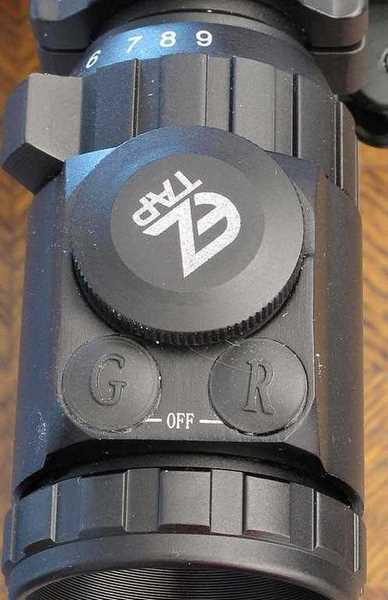
Those two buttons control the colors and intensity of the illuminated reticle. There are 36 choices available.
I will say that you need to read the manual to fully understand how to operate this scope. Not only does it address the EZ-TAP operation, it also goes into great detail on how to estimate range with the mil-dots.
But wait — there’s more!
As if all those features weren’t enough, this scope comes bundled with UTG Max-Strength, quick-detach, medium-height rings. These sell separately for $25, and my friend Mac reviewed them for us in 2011. Mac reviewed 30mm rings and these are one inch, but in all other aspects they’re identical.
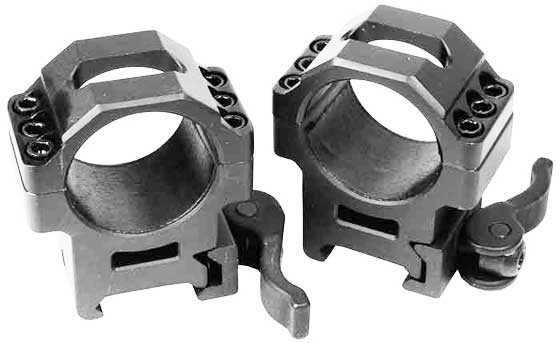
A set of UTG Max-Strength, medium-height, quick-detach rings comes with the Bug Buster.
Packaging
If you’re a store owner, the UTG scope line now comes in glass-clear packaging that allows the customer to see the scope inside. I call it the Snow White box. This packaging is sealed at the factory, so a customer will know if it’s been opened before he receives the scope…because there’s clear film tape that must be removed to get inside the box. That should end the claims of selling used merchandise, which is pretty common in the scope world.
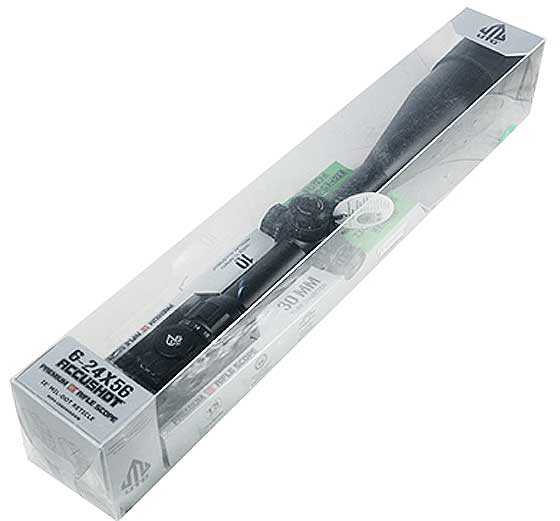
The new UTG packaging is transparent, so everyone can see what’s inside. Clear protective film/tape keeps them out until the scope is sold. Obviously, this doesn’t show the scope from today’s blog, but it demonstrates my point just the same.
Dimensions
The Bug Buster is a compact scope. It’s just 8.5 inches long and weighs only 13.9 ounces. The tube is one inch in diameter. It’ll look petite on most normal air rifles and just right on the small ones. The only consideration the size brings is the scope tube sections are very short on either side of the turret, so the rings don’t have much room to move. If your rifle has a built-in scope stop, this scope may not come back far enough for the proper eye relief. On guns like the 3D bullpup and big bores with short receivers though, the Bug Buster might be the best scope out there.
Testing
The only way to test this scope is by firing the gun and adjusting the reticle. So that testing will have to wait. I can tell you now that the optics are clear and sharp, and the eyepiece has buckets of corrective adjustment in it. The rest will await the testing of the Rainstorm 3D bullpup.

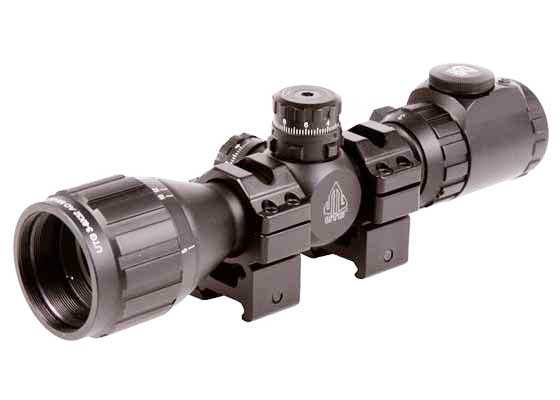
I own several other Leapers scopes, but not this one yet. I’ve always been impressed by the quality and bang for the buck on their tough merchandise! Haven’t broken one yet even though some are mounted on some pretty harsh magnum springers.
/Dave
Everyone,
I’m sorry your morning read was late. The blog crashed just after posting and wasn’t restored until around 10 a.m. EDT.
B.B.
As an owner of several old style Bugbuster scopes, 4 and 6X, it’s good to hear that they’ve finally reduced the thickness of the reticle, which has been my only gripe with these scopes.
I gotta admit I’ve been very impressed with Leapers quality.
I started out with Hawke…an Airmax on my Slavia and a Sidewinder Tactical on my .22WMR. Very happy with both.
When my boys got their Marlin .22’s last year they wanted an ‘army’ scope like the Sidewinder…but though I love ’em to death, I wasn’t about to put $500 scopes on their rifles.
So we opted for the Leapers 4-16x AO scopes with target turrets and illuminated reticle. For $120 I didn’t expect much…but was very pleasantly surprised. They have both held up for thousands of rounds and in truth, at 100m I can’t see all that much difference between them and my Hawke.
Last fall we put a Leapers /product/1x34mm-ita-combat-red-green-dot-sight-1-2-moa-30mm-tube-quick-detach?a=3431 on our Mossberg AR. It has performed flawlessly…again for at least a couple thousand rounds now.
I’m a huge UTG fan now.
BB,
I have been waiting rather impatiently for this review! I plan on getting this one and a 4X in the very near future.
How is the eye relief on this?
RR,
The distance is pretty standard (about 2-3/4-inches) but it is fairly critical. Closer or farther and the exit pupil changes.
B.B.
Well I finaly broke down and bought a Bronco from P.A. and equiped it with the new style bug buster. With this scope on the Bronco you must use an offset mount because of the large plastic cover on the rear of the comp. tube. I used the BKL one piece offset short mount thats the 3 in. mount the 4 in. is too long for the scope. I found this to be a perfect backyard plinker and wasp asasinator. I prefer the 6 power bug buster
Loren
Oooh wasp killing, my favorite! Do you bait them (if so what do you use) or just kill the ones that wander in view?
I’ve been using my Webley Alecto with pretty good results so far, never tought about using a rifle. The Bronco is certainly capable of this.
J-F
No I have not baited the wasps yet but sounds like a good idea, they just seem to like to hang out at my 15 meter target
Loren
Somebody mention wasp hunting ????
For the notorious YJs, sweet (fruit) or meat does the trick.
twotalon
I’m not a hunter, but who in the world doesn’t hate WASPS? The ideal bait is a can of the cheapest cat food you can find. Set it out, wait, and wasp bust for hours.
By the way, if you have a cookout and flying bugs are usually a problem, put a can of cat food at least 25 yards away about an hour before you start cooking, and they ought to leave you an your food alone.
Here’s the drawback: what attracts wasps also attracts bees of every sort. DO NOT KILL BEES! First, there was a major loss in the world’s bee population a few years back, second, they make your flower and vegetable gardens burst with flowers and produce, and finally, all of humanity relies very heavily on bees for crop production. Without bees, we starve, and the animals we eat also starve.
Michael
I still can’t understand how UTG can make such great scopes at low prices? But I’m not complaining. Ive Personally never found a use for the lighted reticle but I know some like it. Every scope I own is a UTG product. I will never pay what some companies charge for the so called higher quality scopes. My two year old Bug Buster has filled my freezer with plenty of squirrels.
Ben,
The nice thing about the illuminated reticle is you never have to turn it on. That’s how I use them.
B.B.
I’m with you, I have a bug buster 3X9 with AO On my dragonfly MK1. It’s perfect on the dragonfly I pest rats at night. I thought I would use the illuminated reticle but even on its lowest setting it wipes out my night vision for the rats. So I too don’t use the illuminated reticle. If I was pesting or hunting something at dusk that was bigger than these rats it might be useful.
Ben,
Leapers HAS to sell them for cheap because there are so many scope makers and re-branders out there blowing them out. They distinguish themselves from the competition by matching the competitors’ low prices but providing a higher quality product for that same low price. Leapers must be operating with a very low margin.
We are seeing one of the principal laws of economics at work: A market with intense competition provides consumers with high quality products at low prices; a market with little or no competition forces poor quality products upon consumers at greatly inflated prices.
Intense market competition also fuels innovation; conversely, a lack of competition makes manufacturers complacent.
Michael
BB this kind of off subject.
But its about being colorblind. I’m not and I always wondered what colorblind people encountered when they see. And you explained that pretty good.
But does it give you a advantage like when there is low light conditions or does that stay the same?
Just curious.
GF1,
In WW II colorblind people were used in photo interpretation because they could see camouflage faster and easier than normal sighted people.
What is really funny is taking a standard colorblindness test. I see one number in the circle and everyone else sees another. It’s humorous.
B.B.
I have red-green color blindness, the most common form. (The others are monchromacy — no color perception, and blue-yellow, both pretty rare.) I can distinguish most reds from most greens, but every now and then a red or green will appear as the other color to me, or simply as a gray. Sometimes a green or red will look red to me in certain light and angles, but green when those factors change.
In general, however, red light produces edges that are perceived as a sharper, and blue produces perceived fuzzier images. Green is closely related to blue, as it contains blue, and so it seems to me that one should choose a red setting for the reticle.
Michael
Odd… I was mentally thinking that higher frequency blue would produce the sharper edges. But maybe it’s causing greater diffraction.
However the comment that “green” contains blue is invalid for /light/ (ignoring that a continuous spectral source — a la the sun — is putting out, well, a continuous spectrum, not a blending of specific wavelengths). The primaries in /light/ are red, green, and blue. Yellow is the blend of red and green, cyan the blend of green and blue; the blend of red and blue is a fiction (it isn’t the middle — green, but something that is neither between blue and ultraviolet, nor between red and infrared…), magenta
In /pigments/, the primaries are yellow, magenta, and cyan — and green is the mix of cyan and yellow, red mixed from yellow and magenta, and blue mixed from magenta and cyan.
BB
I was thinking something on those lines like what you mentioned about the colorblind people during WW II when you was talking about the brightness of the different color recticles of the scope.
So I guess that may help with night vision a little also.
I wear prescription glasses as well as my youngest daughter and we always have to get our eyes checked. And we have to do the colorblind test. So I have always wondered what colorblind people see when they do the test and what they see in other circumstances.
Sometimes it is hard for me to see the numbers but my daughter can see them immediately. They say we both are not colorblind. So the excuse I will use is I’m just getting old and blind. 🙂
I wonder will the bug buster
Be used in part 3 of
Scope dope yep I hope so.
Any secrets to searching the archives of this blog?
I was certain I’ve read a review of the Daisy 22 SG. Can’t find it in the archives,,,and I don’t see it on Pyramid Air anymore.
I typed ‘Daisy 22 SG’ on the search line and found no such article. Perhaps I’m doing something wrong.
Thanks
Eric,
The search facility on the old blog is terrible (this blog’s search isn’t much better). Here’s the post you wanted:
http://airgun-academy.blogspot.com/2005/09/daisy-22sg.html
Edith
Thank you Edith.
B.B.,
A short follow-up from me. The other day I asked about a fellow who makes antique-looking airguns. It must be Mike Reames. My question was how he charged his incredible creations with HPA, but in reading your old posts, I see he uses CO2, no doubt from a standard paintball tank.
It pleases me to see such artisanship, just amazing.
Michael
Michael,
Mike Reames is the guy who made those swages I wrote about. He makes them for his airguns.
B.B.
Any idea how this reticle compares to the non illuminated bug buster or it’s “full size” models?
John,
Compares in what way?
B.B.
Compares in thickness. Oh yeah, and I meant comparing the R-G-Blk bug buster to the IE color version.
John,
Half the thickness or less.
B.B.